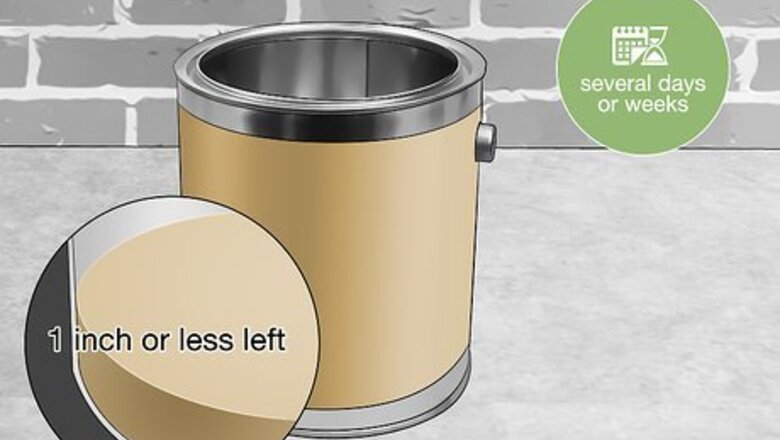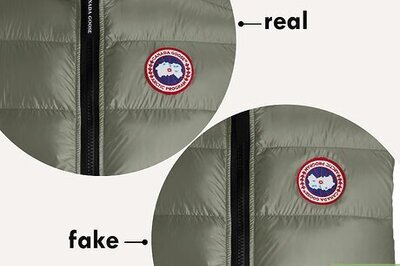
views
How to Get Rid of Leftover Acrylic Paint

Toss dried acrylic paint into your trash can. Jeff Baldwin, a residential painter, says that, “If it’s a small amount [of acrylic paint], you can let it dry out and throw away the can.” Leave the paint in a well-ventilated space for several days so it has a chance to completely dry out before putting it in your trash. Most areas allow you to throw out dried acrylic paint cans as long as they contain less than 1 inch (2.5 cm) of paint. Contact your area’s waste management facilities to find out if there are any other disposal restrictions. For larger amounts, mix the paint with cat litter or a specialty paint hardener. Wait for about an hour for the paint to solidify before throwing it away. Put empty acrylic paint tubes in with your regular garbage. Can wet acrylic paint go in your trash? Since wet paint could still harm the environment, you should always let it dry out before tossing it in your garbage can. If you have jars or containers that still have wet paint inside, wipe them out with paper towels before throwing them away.

Take large amounts of paint to a hazardous waste recycling center. If you have cans or full containers of acrylic paint, contact your city or county waste management service to find the nearest drop-off center. Take your paints directly to the center so they can be properly reused or safely thrown away. Check with local community centers to see if they’re hosting any hazardous waste dropoff events where you can take your old acrylic paints. Try using a site like PaintCare to find local dropoff sites in your area.

Check local paint stores to see if they accept old acrylics. Residential painter Jeff Baldwin recommends checking with the store where you originally purchased the paint to see if they’ll accept your old acrylics. Otherwise, contact hardware stores and other specialty paint shops to check if they’ll take the paint off your hands. You may have to pay a small recycling fee when you take old acrylic paints to a store.

Donate leftover paint to other artists or people in your community. If your paints are still in good condition and can still be used, reach out to neighbors, schools, community centers, or artist studios to see if they could use the acrylics. They’ll definitely appreciate saving money on expensive paint costs.
Disposing of Acrylic Paint Water

Mix the paint water with cat litter and toss it in your trash. Fill a small container with cat litter and pour in the acrylic paint water. Stir the water into the cat litter and let it sit for about an hour to clump up. After that, scoop out the litter and toss it into your trash can. Keep a small container of cat litter near your easel so you can pour in the water as soon as you've finished painting for the day.

Pour the paint water through a coffee filter to remove the acrylics. Set a coffee filter over a container and pour the paint water through it. The acrylic paint residue will separate from the water and stick inside the filter. Then, just pour the clean water down the drain. Leave the acrylic residue in a ventilated, sunny spot so it dries out completely before tossing it in the trash. If you don’t have a coffee filter handy, mesh pantyhose will work well in a pinch.
Can you pour acrylic paint down the sink?

No, you should not pour acrylic paint or paint water in your sink. Jeff Baldwin, a residential painter, says “Don’t pour [acrylic paints] down the drain, into landscaping, or anywhere else it can get into the water table.” Acrylic paint residue can harden and clog your pipes. Additionally, the acrylics are harmful and can pollute the environment. In many areas, it’s illegal to pour paint down the drain or into waterways.
Cleaning Acrylic Paints off Brushes

Wipe off excess paint onto a paper towel. If you still have a lot of paint on your brush, spread the excess into a thin layer on a scrap piece of paper or a paper towel. Try to get as much paint off as you can. After the paint dries, just toss the paper or paper towel out.

Rinse the paint off in a cup of water. Fill a cup with water and swish the brushes around to remove as much loose paint as you’re able to. Clean your brushes thoroughly and pat them dry with a paper towel. Continue swishing your brushes and patting them dry until no more paint comes off of the bristles. Avoid rinsing your brushes in a sink so you aren’t putting any acrylic paint down the drain. Remember to pour the paint water into cat litter or filter out the acrylic residue before pouring it out.

Soak brushes with dried paints in a brush cleaner. If your brushes are gunked up with paint, fill a container with water and add in a squirt of the brush cleaner. Swish the brushes in the soapy water and leave them to soak for about 20–30 minutes. After that, wipe the brushes with a paper towel and rinse them in a cup of clean water. Filter the acrylics out from the water, or mix the water with cat litter to toss it in your trash.



















Comments
0 comment